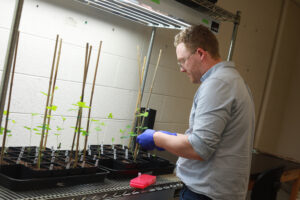
UMW student Harrison Miles spent the summer doing research that used soybean plants and a fungus extracted from lantern flies and could possibly lead to more effective organic pesticides. He’s among 19 Mary Washington students who conducted research to tackle real-world problems during this year’s 10-week Summer Science Institute. Photo by Karen Pearlman.
Harrison Miles fills six plastic cylinders with pieces of leaves from a soybean plant. He slips them inside a machine that resembles a kitchen blender and sets it awhirl. The vials spin so quickly they need time to cool before he begins his next task – extracting the RNA he’ll use for further investigation.
“We create a soup of the fungus,” said Miles, who earned a degree in psychology and elementary education from the University of Mary Washington in 2015, and returned to campus to study conservation biology. “I knew I wouldn’t be able to get this kind of experience anywhere other than Mary Washington.”
Working on Jepson Science Center’s third floor, he spent the summer working with beauveria bassiana harvested from spotted lantern flies shipped in from Pennsylvania. He injected the fungus into soybeans and measured toxin production as the plants grew. The work, done with guidance from Assistant Professor of Biological Sciences Josephine Antwi, could help create more effective organic pesticides.
The project is one of more than a dozen that unfolded during the University’s 24th annual Summer Science Institute (SSI), focused on biology, chemistry, computer science, Earth and environmental sciences, physics and math. The 10-week event had students and faculty working closely together on research aimed at finding solutions to real-world concerns, like pesticides. Read more.